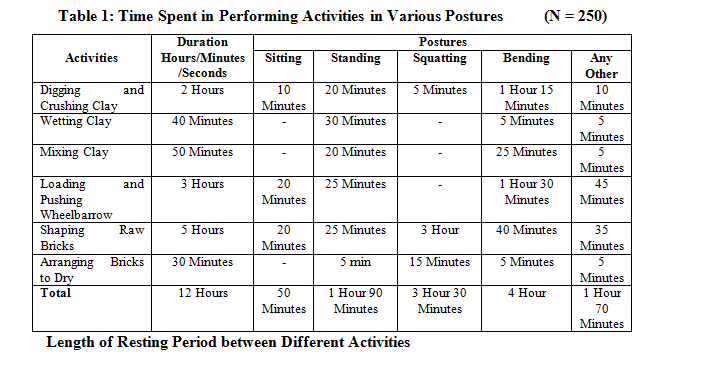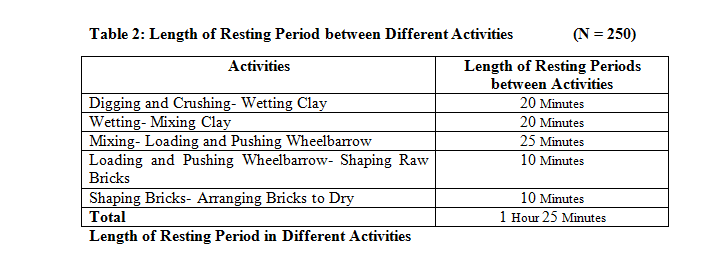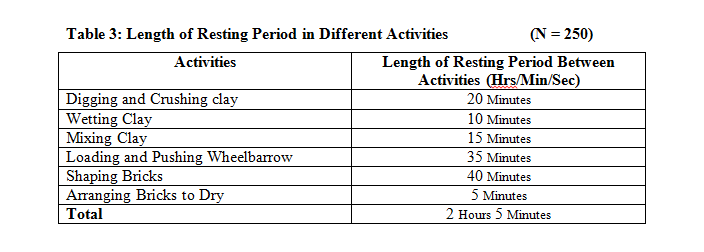Alleviation: An International Journal of Nutrition, Gender & Social Development, ISSN 2348-9340
Volume 5, Number 5 (2018):
© Arya PG College, Panipat & Business Press India Publication, Delhi
www.aryapgcollege.com
Assessing the Performance of Time and Resting Period between Different Activities of Brick Kiln Workers
1. Divya Chaturvedi* & 2. Razia Parvez
1 PhD Research Scholar & 2 Head
Department of Family Resource Management and Consumer Science
Ethleind College of Home Science
Sam Higginbottom University of Agriculture Technology & Sciences (SHUATS) Allahabad, Uttar Pradesh, India
*Email: divyachaturvedi60@gmail.com
Introduction
A number of tasks in brick kiln such as operating brick mould, cutting raw bricks, extracting (digging clay), crushing or grinding clay, mixing clay, carrying clay, loading bricks on the wheelbarrow, arranging bricks to dry are mainly performed manually by male and female brick kiln workers. So the brick kiln workers are the main sufferers who spent most of their time in brick kiln work and therefore experience the biggest amount of exposure and are at greater risk. The brick kiln is not only worker intensive but also a land intensive industry, where common musculoskeletal disorders (MSDs) occur among the workers. There are number of factors which are responsible for MSDs in brick kiln workers. Trevelyen and Haslam (2001) identified upper limb and back problems, poor standing posture and undesirable wrist positions, accompanied by significant force loadings in moulding activity where clay was shaped into bricks in handmade brick kiln.
The term work-related musculoskeletal disorders has been defined by OSHA (Occupational Safety and Health Administration 2000) as disorders of the muscles, nerves, tendons, ligaments, joints, cartilage, blood vessels, or spinal disks in the neck, shoulder, elbow, forearm, wrist, hand, abdomen (hernia only), back, knee, ankle and foot associated with exposure to risk factors. Similarly the National Institute for Occupational Safety and Health (NOISH 1997) defines MSDs as a group of conditions that involve the nerves, tendons, muscles and supporting structures such as inter-vertebral discs. These represent a wide range of disorders, which can differ in severity from mild periodic symptoms to severe chronic and debilitating conditions. According to World Health Organization (2003) work related disorders result from a number of factors and where the work environment and the performance of the work contribute significantly, but in varying magnitude, to causation of disease.
Occupational Health and Safety Administration (1970) clearly states that the general duty of all employers is to provide their employees with a workplace free from recognized serious hazards. This also includes the prevention and control of these hazards. The incident and severity of musculoskeletal disorders and other workplace injuries and illness in the industry demand that effective programs should be implemented to protect workers from these hazards. The goal of any health and safety program is to prevent hazards and illness by removing their causes. For ergonomic hazards, this goal is achieved through taking steps to eliminate or materially to reduce workers exposure to conditions related to musculoskeletal disorders related injuries and illness. Because of the huge population of India, any slight improvement at the individual level would yield very significant qualitative effect in total, especially in unorganized sectors such as agriculture and poultry where an application of ergonomics is much less common than in organized sectors. This is mainly due to lack of awareness of basic principles, poor working conditions and reluctance to change existing and traditional work methods and tools. Despite of so much of mechanization, musculoskeletal disorders include a variety of injuries and disorders of wrist, arms, shoulders, neck and back as well lower extremities.
Material and Methods
The study was conducted at Allahabad (Uttar Pradesh). A sample size of 250 workers (125 Males and 125 Females) was purposively selected on the availability of brick kiln workers. Most of male and female workers were between 20-50 years of age, used to perform brick kiln activities more than 12 hours per day and were engaged in brick kiln activities for more than 5 years. The questionnaire was developed to find out the responses of the workers.
Results and Discussion
Time Spent in Performing Activities in Various Postures
Data showed (Table 1) that total 12 hours of time was taken by all brick making activity, 2 hours were taken for digging and crushing activity which was mainly done in standing posture. Total 40 minutes required for completing wetting clay which was mostly done in standing posture for 30 minutes. Data also revealed that mixing clay took 50 minutes which was mostly done in bending posture for 25 minutes. Workers loaded and pushed the wheelbarrow for 3 hours where they adopted mostly bending posture for 1 hour and 30 minutes. It was found that shaping of bricks required total 5 hours where they adopted squatting posture for 3 hours and bending posture for 40 minutes.
Drying of bricks was completed in 30 minutes in which the workers adopted mostly squatting posture. Out of total 12 hours of time, workers adopted sitting posture for 50 minutes, standing for 1 hour and 90 minutes, squatting for 3 hours and 30 minutes, bending for 4 hours and any other posture for 1 hour and 70 minutes.

It can be seen in the Table 2 that total 1 hour and 25 minutes of resting period was taken by the brick kiln workers between different activities. It was found that resting period in digging and crushing clay-wetting clay was 20 minutes, 20 minutes in wetting-mixing clay, 25 minutes between mixing loading and pushing wheelbarrow, 10 minutes between loading and pushing wheelbarrow-shaping raw bricks and 10 minutes between shaping drying bricks.

Data showed (Table 3) that total 1 hour and 25 minutes of resting period taken by employees in performing different activities. It was found that resting period in digging and crushing clay was 20 minutes, 10 minutes in wetting, 15 minutes in mixing, 35 minutes in loading and pushing wheelbarrow, 40 minutes in shaping raw bricks, and only 5 minutes in drying bricks activities.

Conclusions
The result of the study pointed out the number of important factors that must be addressed which included the work place design necessitating frequent bending and twisting of trunk and handling techniques. Other problems such as inadequate breaks and high speed of work also needed to be address.
References
National Institute for Occupational Safety and Health (1997) Work-Related Musculoskeletal Disorders (NOISH Facts, Document No. 705005). USA: NIOSH.
Occupational Health and Safety Administration (1970) The Occupational Health and Safety Act. United States Official Gazette Supplement 11 (12): 23-36.
Occupational Safety and Health Administration (2000) Ergonomics Program. United States: Department of Labor : 68262-68870.
Trevelyan FC and Haslam RA (2001) Musculoskeletal Disorders in a Handmade Brick Manufacturing Plant. International Journal of Industrial Ergonomics, 27: 43-55.
World Health Organization (2003) Protecting Workers Health: Preventing Musculoskeletal Disorders at the Workplace. Geneva: World Health Organization.

